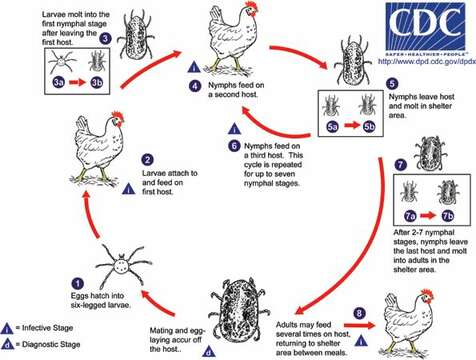Multihost life cycle for argasid (soft) ticks.

Description :
Multihost life cycle for argasid (soft) ticks.
Unlike the Ixodidae (hard ticks), members of the family Argasidae (soft ticks) have two or more nymphal stages, each of which requires a blood meal. This pattern is referred to as the multihost life cycle. Two species of public health concern in the United States, Ornithodoros hermsi and O. turicata, are vectors of tick-borne relapsing fever (TBRF) spirochetes. In Africa and Asia, O. moubata is a vector of TBRF spirochetes. Members of the genus Carios are vectors of TBRF spirochetes in Central and South America.
In argasid ticks, mating usually occurs (and egg-laying always occurs) off the host in a sheltered area, usually an animal nest. Eggs hatch into six-legged larvae (1) in the parents’ sheltered area. Larvae search for a host in the vicinity of the sheltered area. Once a suitable host is found, they feed for anywhere from one hour to several days, depending on the species (2). After feeding, the larvae leave the host and molt into the first nymphal instars in the sheltered area (3a-3b). The nymphs search for, and feed on, the second host (4) rapidly (usually about an hour). The second host is usually the same species, and often the same individual, as the first host. The first nymphal instars leave the host and molt into the next nymphal instars in the sheltered area >(5a-5b). This cycle can continue to accommodate up to seven nymphal instars (6), depending on the species. After the last nymphal instar has fed, it leaves the host and molts into an adult (7a-7b) in the sheltered area. Adults may continue to feed on the host (8), feeding rapidly and detaching after each blood meal. Females of some species lay egg batches after each meal. Humans are usually only incidental hosts for argasid ticks and may be fed upon by any of the stages.
From Centers for Disease Control Parasites and Health website.
Inclus dans les pages suivantes :
- Life
- Cellular (Organismes cellulaires)
- Eukaryota (eucaryotes)
- Opisthokonta
- Metazoa (animaux)
- Bilateria
- Protostomia
- Ecdysozoa
- Arthropoda (Arthropodes)
- Chelicerata (Chélicérates)
- Arachnida (Arachnide)
- Acari (acariens)
- Parasitiformes
- Ixodida (Tique)
- Ixodoidea
- Argasidae
- Ornithodoros
- Ornithodoros moubata
- Panarthropoda
Cette image ne figure dans aucune collection.
Informations sur la provenance
- licence
- cc-by-nc
- droit d’auteur
- Centers for Disease Control/Division of Parasitic Diseases and Malaria
- éditeur de publication
- Shapiro, Leo
- photographe
- Centers for Disease Control/Division of Parasitic Diseases and Malaria
- fournisseur
- EOL Rapid Response Team
- original
- fichier de média d’origine
- visiter la source
- site partenaire
- EOL staff
- ID


